Ankle Sprain or Ankle Strain?
Is it a muscle strain or sprain? Both forms of injury have one thing in common – they both hurt, but there is a difference between them in terms of anatomy. Here’s how to tell the difference between a muscle strain and a sprain.
What is a Muscle Strain?
A muscle strain occurs when a muscle or tendon, a thick, band of connective tissue that connects the muscle to the underlying bone, is injured due to excessive pulling or overuse. The typical example is when a muscle is stretched or pulled too far as when lifting a heavy object or a weight. With a strain, muscle fibers may be torn which leads to the development of local inflammation and pain. It should come as no surprise that muscle strains are frequent in weightlifters and other athletes, but strains can also occur when performing day to day activities such as bending over to pick up a child, particularly when muscles are not well conditioned.
What is a Sprain?
A sprain involves injury to a ligament. A ligament is a band of thick tissue that connects bone to bone, creating a joint which it helps to stabilize. Ligaments can be stretched and their fibers torn just as muscles and tendons can be. Sprains occur when there’s a fall which causes an extremity such as the ankle to roll, or when a twisting motion causes a ligament to be stretched too far. The classic example of this is a twisted ankle, an injury which can be quite painful.
Muscle Strain or Sprain: What are the Symptoms?
Although strains and sprains involve different anatomical parts, the symptoms are similar in both. The most prominent symptom is pain along with difficulty moving the affecting area. There can also be significant swelling. With a sprain, the swelling is usually more pronounced than with a strain and there may be visible bruising. If the ligament is torn, a popping sound may be heard at the time of injury and weight bearing can be difficult or impossible if it involves the ankle. Most sprains can be treated at home, but significant ligament tears may require surgery.
Muscle Strain or Sprain: How Does the Treatment Differ?
Most muscle strains and sprains are treated in a similar manner. The mnemonic for treatment is RICE which stands for rest, ice, compression, and elevation. An ACE wrap applied to the affected area is usually used for compression. NSAID’s may be taken for pain in those who can tolerate them. Once the pain and swelling start to improve, special exercises are generally recommended to reduce stiffness and gradually increase mobility. Sprains that fail to improve need evaluation by a doctor since some ligament tears may require surgery. If there was a fall, x-rays may be needed to rule out a fracture.
Visit our PRP Injections page to learn more about the treatment options.

